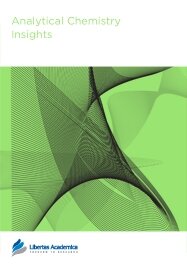

Publication Date: 18 Nov 2008
Journal: Analytical Chemistry Insights
Citation: Analytical Chemistry Insights 2008:3 145-155

New simple spectrofluorimetric method with enhanced sensitivity has been developed and validated for the determination of the antidepressant paroxetine (PXT) in its dosage forms and plasma. The method was based on nucleophilic substitution reaction of PXT with 4-chloro-7-nitrobenzo-2-oxa-1,3-diazole in an alkaline medium (pH 8) to form a highly fluorescent derivative that was measured at 545 nm after excitation at 490 nm. The factors affecting the reaction was carefully studied and optimized. The kinetics of the reaction was investigated, and the reaction mechanism was presented. Under the optimized conditions, linear relationship with good correlation coefficient (0.9993) was found between the fluorescence intensity and PXT concentration in the range of 80–800 ng ml−1. The limits of detection and quantitation for the method were 25 and 77 ng ml−1, respectively. The precision of the method was satisfactory; the values of relative standard deviations did not exceed 3%. The proposed method was successfully applied to the determination of PXT in its pharmaceutical tablets with good accuracy; the recovery values were 100.2 ± 1.61%. The results obtained by the proposed method were comparable with those obtained by the official method. The proposed method is superior to the previously reported spectrofluorimetric method for determination of PXT in terms of its higher sensitivity and wider linear range. The high sensitivity of the method allowed its successful application to the analysis of PXT in spiked human plasma. The proposed method is practical and valuable for its routine application in quality control and clinical laboratories for analysis of PXT.
PDF (460.44 KB PDF FORMAT)
RIS citation (ENDNOTE, REFERENCE MANAGER, PROCITE, REFWORKS)
BibTex citation (BIBDESK, LATEX)
XML
PMC HTML


I have published more than thirty research papers in internationally reputed high impact factor journals including Libertas Academica publications, Proteomics Insights and Analytical Chemistry Insights. I have no hesitation in saying that Proteomics Insights is highly efficient for its rapid and high quality review process and keeping the authors informed at each stage of the publication process. I recommend this journal for students, teachers and research workers who wish to publish their work. ...
Facebook Google+ Twitter
Pinterest Tumblr YouTube